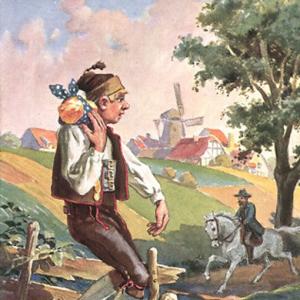Reading time: 7 min
A couple of large ships were sent up toward the North Pole, to discover the boundaries of land and sea and how far it would be possible for the human race to penetrate in that direction.
A year and a day had already passed, and with great difficulty they had traveled high up amid mist and ice. Now winter had set in again. The sun was gone, and one long night would last for many, many weeks. All around them was a vast, unbroken plain of ice, and ships were moored fast to the ice itself. The snow was piled high, and huts were made of it in shape of beehives, some as big as our barrows, others just large enough to give shelter for two or four men. However, it wasn’t dark, for the northern lights flashed red and blue-it was like everlasting, splendid fireworks-and the snow glittered brightly; here the night was one long, blazing twilight.
At the time when it was brightest, troops of natives came, strange-looking figures, dressed in hairy skins and dragging sleighs made from ice blocks. They brought skins in large bundles, which served as warm rugs for the snow huts and were used as beds and bed blankets, upon which the sailors could rest, while outside the cold was more intense than we ever experience even in our severest winters.
And the sailors remembered that at home it was still autumn, and they thought of the warm sunbeams and the glorious crimson and gold of the leaves still clinging to the trees. The clock showed it was evening and time for going to bed, and in one of the snow huts two sailors had already lain down to rest.
The younger of these two had with him his most treasured possession from home, the Bible that his grandmother had given him at parting. From childhood he had known what was written in it; every night it was under his pillow, and every day he read a portion; and often as he lay on his couch he remembered those words of holy comfort, „If I take the wings of the morning and dwell in the uttermost parts of the sea; even there shall thy hand lead me, and thy right hand shall hold me.“
Under the influence of those sublime words of faith, he closed his eyes. Sleep came to him, and dreams came with sleep. He dreamed that, although the body may sleep, the soul must ever be awake. He felt this life, and he seemed to hear the old well-known songs so dear to him; a gentle summer breeze seemed to breathe upon him, and a light shone down upon his couch, as though the snowy dome above had become transparent. He lifted his head and lo! the dazzling white light did not come from the walls or the ceiling. It was the light of the great wings of an angel, into whose gentle, shining face he looked.
Rising up from out of the pages of the Bible, as from the mouth of a lily blossom, the angel extended its arms way out, and the walls of the snow hut sank back as if they were a light airy veil of fog. The green meadows and hills of his home lay about him, with the red-brown woods bathed in the gentle sunshine of a beautiful autumn day. The storks‘ nest was empty now, but the apples still clung to the wild apple trees; though leaves had fallen, the red hips glistened and the blackbird whistled in the little green cage over the window of the little farmhouse-his old home. The blackbird was whistling a tune that he himself had taught him, and the old grandmother twined chickweed about the bars of the cage, just as her grandson had always done.
The pretty young daughter of the blacksmith was standing at the well, drawing water, and as she waved to the grandmother, the latter beckoned to her and showed her a letter that had come that morning from the frigid lands of the North, far, far away, from the North Pole itself, where her grandson now was-safe beneath the protecting hand of God. They laughed and they cried; and all the while that young sailor whose body slept amid the ice and snow while his spirit roamed the world of dreams, under the angel’s wings, saw and heard everything and laughed and cried with them.
Then from the letter they must read aloud these words from the Bible, „Even at the uttermost parts of the sea His right hand shall hold me fast“; and a beautiful psalm song sounded about him, and the angel folded its wings. Like a soft, protecting veil they fell close over the sleeper.
The dream was ended, and all was darkness in the snow hut; but the Bible lay beneath the sailor’s head, while faith and hope dwelt in his heart. God was with him and his home was with him, „even at the uttermost parts of the sea.“
 Learn languages. Double-tap on a word.Learn languages in context with Childstories.org and Deepl.com.
Learn languages. Double-tap on a word.Learn languages in context with Childstories.org and Deepl.com.Backgrounds
Interpretations
Adaptions
Summary
Linguistics
„At the Uttermost Parts of the Sea“ is a lesser-known fairy tale written by the famous Danish author Hans Christian Andersen. Andersen was born on April 2, 1805, in Odense, Denmark, and lived until August 4, 1875. He is widely known for his collection of fairy tales, including classics such as „The Little Mermaid,“ „The Ugly Duckling,“ and „The Emperor’s New Clothes.“ Andersen’s stories have been translated into more than 150 languages and have inspired numerous adaptations across various art forms, such as ballet, theater, and film.
Hans Christian Andersen’s tales often contain moral lessons, and „At the Uttermost Parts of the Sea“ is no exception. In this story, Andersen explores themes of faith, hope, resilience, and the importance of maintaining connections to one’s roots. The story’s setting in the Arctic region represents the extreme and challenging circumstances that the characters must face, while the angelic dream sequence offers a spiritual perspective that transcends the physical world.
Although „At the Uttermost Parts of the Sea“ might not be as well-known as some of Andersen’s other works, it still captures the essence of his storytelling style, which combines vivid imagination, emotional depth, and strong moral themes.
„At the Uttermost Parts of the Sea“ offers various interpretations that highlight different aspects of the human experience:
The power of faith: The young sailor’s strong faith in God is a central theme of the story. Despite being in a desolate and harsh environment, his belief in God’s protection remains unwavering. The Bible verse he quotes, „Even at the uttermost parts of the sea His right hand shall hold me fast,“ serves as a reminder that divine protection is not limited by physical boundaries.
The significance of home and family: The story emphasizes the importance of maintaining a connection with one’s home and family, even when physically separated. The dream sequence allows the young sailor to reconnect with his grandmother and the familiar surroundings of his homeland. This connection brings comfort and warmth to the sailor, despite the cold and darkness of the Arctic.
The resilience of the human spirit: The sailors‘ ability to adapt to the harsh conditions of the North Pole showcases the resilience of the human spirit. They build snow huts, accept gifts from the natives, and find solace in their memories of home. The young sailor’s dream further illustrates the power of the human spirit to transcend physical barriers and find strength in hope and faith.
The interplay between the physical and spiritual realms: The story suggests that the physical world is intertwined with the spiritual realm, as evidenced by the angel’s appearance in the young sailor’s dream. This connection implies that even in the most remote and inhospitable environments, spiritual support and guidance can be found.
Overall, „At the Uttermost Parts of the Sea“ presents a message of hope, faith, and resilience that transcends physical boundaries and hardships. The story reminds readers of the importance of maintaining connections with their roots and the power of the human spirit to overcome adversity.
There have been several adaptations of Hans Christian Andersen’s fairy tale „At the Uttermost Parts of the Sea“ in various forms of media. Here are a few notable examples.
„The Little Mermaid“ (1989) – While not a direct adaptation of „At the Uttermost Parts of the Sea,“ the Disney animated film „The Little Mermaid“ is based on another of Andersen’s fairy tales and shares similar themes of exploration and adventure. The film also features a memorable song titled „Part of Your World,“ in which the main character expresses her desire to explore beyond her familiar surroundings.
„The Uttermost Parts of the Sea“ (2013) – This stage play by Don Zolidis is a direct adaptation of Andersen’s fairy tale. It was first performed by the Lakewood High School Drama Department in Ohio and has since been produced by other theater groups.
„At the Uttermost Parts of the Sea“ (2019) – This short film adaptation of Andersen’s fairy tale was created by the animation studio Spindle Horse Toons. It tells the story of Prince Peter’s quest to find the magical flower and features a colorful, whimsical animation style.
„The Little Prince“ (2015) – While not a direct adaptation of „At the Uttermost Parts of the Sea,“ Antoine de Saint-Exupéry’s classic novella shares similar themes of adventure and self-discovery. The story follows a young prince as he travels from planet to planet and meets a variety of quirky characters, ultimately learning important life lessons along the way.
These adaptations demonstrate the enduring appeal of Andersen’s themes of adventure, exploration, and self-discovery, and how they can be reimagined and reinterpreted across different forms of media.
„At the Uttermost Parts of the Sea“ is a fairy tale by Hans Christian Andersen that follows a group of sailors on an expedition to the North Pole. The story begins with the ships arriving at the icy and treacherous Arctic region, where they build snow huts to protect themselves from the harsh winter.
During the brightest part of the long Arctic night, natives visit the sailors, bringing them skins to use as warm blankets. The sailors find comfort in these gifts and reminisce about their homes, where it is still autumn. Among them is a young sailor who holds dear a Bible given to him by his grandmother.
One night, as the young sailor drifts off to sleep with the Bible under his pillow, he experiences a vivid dream in which an angel emerges from the pages of the holy book. The angel’s wings emit a dazzling light that transforms the snow hut into a vision of the sailor’s homeland. In the dream, he sees his grandmother, the blacksmith’s daughter, and the familiar landscape of his home.
The dream also reveals a letter that the grandmother has received from her grandson, which quotes the Bible verse, „Even at the uttermost parts of the sea His right hand shall hold me fast.“ Both the young sailor and his grandmother are moved to tears by this message of hope and faith.
When the dream ends, darkness returns to the snow hut, but the sailor’s faith remains strong. The tale illustrates the power of faith and the comfort of home, even when faced with the most challenging and remote circumstances.
The linguistic analysis of Hans Christian Andersen’s fairy tale „At the Uttermost Parts of the Sea“ reveals several notable features of style, structure, and thematic content. Andersen’s writing style and thematic elements in this narrative can be analyzed through the lens of language and literary devices.
Descriptive Language: Andersen is known for his vivid and detailed descriptions, and this tale is no exception. He creates a stark contrast between the icy, desolate setting of the Arctic and the warmth and comfort of the sailor’s memories. Words like „vast, unbroken plain of ice,“ „long, blazing twilight,“ and „crimson and gold of the leaves“ evoke strong visual imagery and highlight the geographical and emotional distances the sailors are experiencing.
Imagery and Symbolism: The story is rich in imagery, particularly in the portrayal of the Arctic landscape. The Northern Lights are described as „everlasting, splendid fireworks,“ symbolizing beauty amidst desolation. The snow huts, resembling „beehives,“ suggest a sense of community and survival in harsh conditions. The angel’s wings symbolize divine protection and guidance, reinforcing the spiritual theme in the narrative.
Contrast and Juxtaposition: Andersen expertly uses contrast to emphasize the differences between the harsh Arctic environment and the warmth of home. The „intense“ cold of the Arctic is juxtaposed with memories of the „warm sunbeams“ and „beautiful autumn day,“ enhancing the emotional impact of the sailor’s longing and nostalgia. This contrast also underscores the theme of inner strength and resilience in the face of adversity.
Religious and Spiritual Themes: The tale prominently features religious references, particularly through the sailor’s reflection on the Bible. The repeated phrase „even at the uttermost parts of the sea“ emphasizes God’s omnipresence and the theme of divine protection. The sailor’s faith is portrayed as a source of comfort and strength, enabling him to find solace even in the most remote and inhospitable places.
Dream as Narrative Device: The dream sequence serves as a narrative device to bridge the gap between the sailor’s current reality and his memories of home. It allows Andersen to explore the sailor’s inner emotional landscape, juxtaposed against the external harshness of the Arctic. The dream blurs the lines between reality and imagination, providing an escape and emphasizing the power of the human spirit.
Structure and Flow: The story’s flow combines a linear narrative with a reflective, introspective quality when the sailor dreams. This dual structure enables Andersen to convey a message of hope and resilience while maintaining a connection to the physical journey of exploration.
Language and Tone: The language in the narrative oscillates between the practical and the poetic. Practical descriptions of the sailors’ conditions and their environment are interwoven with poetic language that highlights the beauty of the Northern Lights and the spiritual experience of the sailor. This interplay of tone reflects the coexistence of hardship and hope.
Overall, Hans Christian Andersen’s „At the Uttermost Parts of the Sea“ is a blend of vivid imagery, spiritual themes, and emotional depth. Through its linguistic elements, the tale explores the human capacity for faith, hope, and resilience in the face of isolation and adversity.
Information for scientific analysis
Fairy tale statistics | Value |
|---|---|
| Translations | DE, EN, DA, ES |
| Readability Index by Björnsson | 40.9 |
| Flesch-Reading-Ease Index | 70.7 |
| Flesch–Kincaid Grade-Level | 10.4 |
| Gunning Fog Index | 13 |
| Coleman–Liau Index | 8.8 |
| SMOG Index | 9.5 |
| Automated Readability Index | 12 |
| Character Count | 4.527 |
| Letter Count | 3.543 |
| Sentence Count | 30 |
| Word Count | 848 |
| Average Words per Sentence | 28,27 |
| Words with more than 6 letters | 107 |
| Percentage of long words | 12.6% |
| Number of Syllables | 1.077 |
| Average Syllables per Word | 1,27 |
| Words with three Syllables | 36 |
| Percentage Words with three Syllables | 4.2% |

 Facebook
Facebook  Whatsapp
Whatsapp  Messenger
Messenger  Telegram
Telegram Reddit
Reddit














